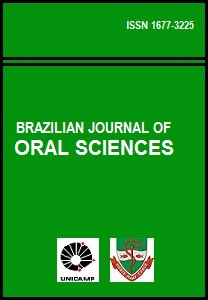Abstract
This study evaluated the shear bond strength of two adhesive systems: Scotchbond Multi-Purpose (SBMP) and Clearfil Liner Bond 2V (CLB2V) on different dentin surface conditions. Bovine incisors were collected and prepared according to the ISO’s (TR 11405) directions. The samples were divided into nine groups (n=10): 1- SBMP control group (without contamination); 2-SBMP: saliva contamination after priming; 3- SBMP: saliva contamination after bond application; 4-SBMP: saliva contamination after acid etching; 5-SBMP: as group 4 with re-etching after saliva contamination; 6-CLB2V control group (without contamination); 7-CLB2V: saliva contamination after priming; 8-CLB2V: saliva contamination after bond application; and, 9-CLB2V: saliva contamination before priming. After the storage period in water at 37o C, the samples were tested with an Instron testing machine, at crosshead speed of 0.5mm/min. The results were submitted to ANOVA (one way) and Tukey’s test at 5% significance level. For SBMP groups, the mean shear bond strengths were: 1 - 4.8 MPa, 2 - 5.0 MPa, 3 - 5.2 MPa, 4 - 6.6 MPa and 5 - 4.2 MPa. There was no statistical difference among groups tested. For CLB2V groups 6, 8, 9, the mean shear bond strengths were 8.0 MPa, 6.9 MPa and 8.8 MPa respectively and demonstrated no statistical differences. Group 7 (4.7 MPa) differed from all other groups except 8. Slight salivary contamination does not influence the shear bond strength of SBMP during any stage and slight salivary contamination influences the shear bond strength of CLB2V after priming step.References
Buonocore MG. A simple method of increasing the adhesion of acrylic filling materials to enamel surfaces. J Dent Res 1955; 34: 849-53.
Davila JM, Gwinnett AJ, Robles JC. Marginal adaptation of composite resins and dentinal bonding agents. J Dent Child 1988; 55: 25-8.
El-Kalla IH, Garcia-Godoy F. Saliva contamination and bond strength of single-bottle adhesives to enamel and dentin. Am J Dent 1997; 10: 83-7.
Abdalla AI, Davidson CL. Bonding efficiency and interfacial morphology of one-bottle adhesives to contaminated dentin surfaces. Am J Dent 1998; 11: 281-5.
Davidson CL, De Gee AJ. The competition between the composite dentin bond strength and the polymerization contraction stress. J Dent Res 1984; 63: 1396-9.
Perdigão J, Lopes M. The effect of etching time on dentin demineralization. Quintessence Int 2001; 32: 19-26.
El-Kalla IH, Garcia-Godoy F. Saliva contamination and bond resin micromorphological adaptation to cavity walls using single-bottle adhesives. Am J Dent 1999; 12: 172-6.
Fritz UB, Finger WJ, Stean H. Salivary contamination during bonding procedures with a one-bottle adhesive system. Quintessence Int 1998; 29: 567-72.
Lee SY, Lin CT. Storage effect on dentin struture and on resultant composite bond strengths. J Oral Rehabil 1997; 24: 823-34.
Glantz POJ, Arnebrant T, Nylander T. Bioadhesion - a phenomenon with multiple dimensions. Acta Odontol Scand 1999; 57: 238-41.
Benderli Y, Gökçe K, Büyükgökçesu S. In vitro shear bond strength of adhesive to normal and fluoridated enamel under various contaminated condition. Quintessence Int 1999; 30: 570-5.
Shimada Y, Harnirattisai C, Inokoshi, S. In vivo adhesive interface between resin and dentin. Oper Dent 1995; 20Browning WD, Myers ML, Nix LB. Constancy of bond strength in 5 single-bond dentin bonding systems. Quintessence Int 2001; 32: 249-53.
Hansen EK, Munksgaard EC. Saliva contamination vs efficacy of dentin bonding agents. Dent Mater 1989; 5: 329-33.
Anusavice KJ. Phillips Materiais Dentários. 10.ed. Guanabara Koogan: Rio de Janeiro; 1996. p.178.
Pashley DH, Nelson R, Kepler EE. The effect of plasma and salivary constituents on dentin permeability. J Dent Res 1982; 61: 978-81.
Xie J, Powers JM, Mc Guckin RS. In vitro bond strength of two adhesives to enamel and dentin under normal and contaminated condition. Dent Mater 1993; 9: 295-9.
Nakabayashi N, Pashley DH. Hybridization of Dental Hard Tissues. Tokyo: Quintessence Publishing; 1998, 129p.
Koibuchi H, Yasuda N, Nakabayashi N. Bonding to dentin with a self-etching primer: the effect of smear layers. Dent Mater 2001; 17: 122-6.
Perdigão J, Frankenberger R. Effect of solvent and rewetting time on dentin adhesion. Quintessence Int 2001; 32: 385-90.
The Brazilian Journal of Oral Sciences uses the Creative Commons license (CC), thus preserving the integrity of the articles in an open access environment.

